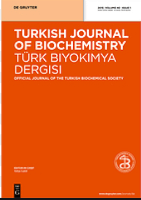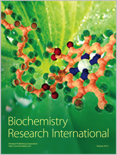
Turkish Journal of Biochemistry-Turk Biyokimya Dergisi
Scope & Guideline
Fostering collaboration in the evolving landscape of biochemistry.
Introduction
Aims and Scopes
- Biochemical Mechanisms in Disease:
The journal focuses on elucidating the biochemical pathways involved in various diseases, including cancer, diabetes, cardiovascular diseases, and autoimmune disorders. This includes studies on biomarkers, metabolic pathways, and molecular interactions that contribute to disease progression. - Translational Research:
A significant aim is to translate biochemical research into clinical applications. This includes the exploration of potential biomarkers for early diagnosis, treatment efficacy, and disease prognosis, particularly in cancer and metabolic disorders. - Innovative Methodologies:
The journal encourages the use of novel methodologies, such as in vitro and in vivo models, advanced imaging techniques, and computational approaches, to investigate biochemical processes and their clinical relevance. - Nutritional Biochemistry:
Research on the biochemical effects of nutrients, dietary components, and supplements on health outcomes is a core area, with a focus on how these factors influence disease mechanisms and treatment responses. - Environmental and Clinical Biochemistry:
The journal also covers studies related to the impact of environmental factors on biochemical processes, as well as the biochemical basis of laboratory diagnostics and the assessment of laboratory practices.
Trending and Emerging
- Biomarkers and Diagnostics:
There is a notable increase in research focused on identifying and validating biomarkers for early disease detection, particularly in cancer and chronic diseases. This trend underscores the importance of non-invasive diagnostics in improving patient outcomes. - COVID-19 Related Research:
Research centered on the biochemical aspects of COVID-19, including its pathophysiology, biomarkers for disease severity, and the effects of treatments, has surged. This reflects the global health crisis and its impact on biochemistry research priorities. - Nutritional Biochemistry and Metabolism:
Emerging studies are increasingly exploring the biochemical impacts of nutrition on health, disease prevention, and management. This encompasses research on dietary supplements, metabolic syndrome, and the role of specific nutrients in chronic diseases. - Cancer Metabolism and Therapeutics:
A growing number of publications are focused on the metabolic pathways of cancer cells and the development of novel therapeutic strategies targeting these pathways. This trend indicates a shift towards understanding cancer not just as a genetic disease but also as a metabolic disorder. - Machine Learning and Bioinformatics Applications:
The incorporation of machine learning and bioinformatics in analyzing biochemical data is becoming more prevalent. This trend reflects the need for advanced analytical techniques to handle complex biological data and improve predictive modeling in biochemistry.
Declining or Waning
- Basic Biochemical Studies:
There appears to be a waning interest in purely basic biochemical studies that do not directly connect to clinical implications or translational research. The journal is increasingly favoring studies with clear practical applications or implications for health. - Traditional Laboratory Techniques:
Papers focusing on traditional laboratory techniques without innovative adaptations or significant clinical relevance have declined. The shift towards automation and advanced diagnostic methods has overshadowed these studies. - Single-Factor Studies:
Research that focuses solely on individual biochemical factors without considering their interactions or broader biological contexts has become less common. The trend is moving towards integrative approaches that consider multiple factors and their interactions. - Solely Theoretical Reviews:
The journal has seen a decrease in the publication of theoretical reviews that do not provide new insights or practical applications. There is a growing preference for reviews that synthesize findings with a clear focus on future research directions or clinical applications.
Similar Journals

Biochemistry and Biophysics Reports
Charting new territories in molecular and cellular biology.Biochemistry and Biophysics Reports, published by Elsevier, serves as a vital platform for the dissemination of innovative research in the fields of biochemistry, biophysics, cell biology, and molecular biology. With an Open Access model initiated in 2015, this journal aims to facilitate the unimpeded sharing of knowledge, allowing researchers, professionals, and students free access to significant findings and developments. The journal has established a presence in the academic community, currently holding a Q3 ranking in Biochemistry, Q2 in Biophysics, alongside its Q3 standings in both Cell Biology and Molecular Biology categories for 2023. These metrics underscore its commitment to quality and relevance, garnering attention with Scopus ranks reflecting its emerging influence. Located in the Netherlands, Biochemistry and Biophysics Reports continues to foster dialogue and collaboration among the scientific community through high-quality research outputs, contributing to advancements in understanding the intricate biochemical processes and biophysical principles that underpin life sciences.

Biochemistry Research International
Fostering innovation in biochemistry through open access research.Biochemistry Research International is a prominent and dynamic journal published by Hindawi Ltd, dedicated to advancing knowledge in the field of biochemistry. With its Open Access model established since 2010, the journal provides unrestricted access to high-quality research, thereby fostering global communication among researchers and professionals. Operating out of the United States, Biochemistry Research International serves as a vital platform for disseminating cutting-edge findings in biochemistry and molecular biology, holding a respectable Q2 ranking in its category as of 2023. The journal's scope encompasses a wide array of topics including but not limited to biochemical processes, genetic engineering, and molecular interactions, making it an essential resource for students and seasoned researchers alike. With an impact factor reflective of its significance in the academic community, Biochemistry Research International continues to play an integral role in shaping the future of biochemistry research.

Molecular Biomedicine
Transforming Knowledge into Biomedical BreakthroughsMolecular Biomedicine is a prestigious peer-reviewed journal published by SpringerNature, dedicated to advancing the fields of molecular biology and molecular medicine. With a commendable Q1 ranking in both categories for 2023, this journal stands out for its rigorous exploration of the biochemical processes underlying health and disease. Operating out of Germany, Molecular Biomedicine aims to provide comprehensive insights into cutting-edge research, facilitating interdisciplinary collaboration among researchers, healthcare professionals, and students alike. The journal's impact is reflected in its Scopus rankings, placing it in the upper echelons of the fields of biochemistry, genetics, and molecular biology. As an open access platform, it commits to disseminating knowledge widely, ensuring that pivotal discoveries are accessible to all. Researchers looking to publish in a dynamic environment that prioritizes innovation and application in the biomedical sciences will find Molecular Biomedicine an ideal outlet for their work.

Frontiers in Nutrition
Fostering collaboration to enhance nutritional understanding.Frontiers in Nutrition, published by FRONTIERS MEDIA SA, is a leading open access journal dedicated to advancing the field of nutrition through rigorous research and innovative insights. Since its inception in 2014, it has established itself as a key resource for researchers, healthcare professionals, and policymakers interested in the multidimensional aspects of nutrition and its impact on health and disease. The journal boasts a commendable reputation with a quartile ranking of Q1 in Food Science and multiple Q2 rankings in Endocrinology, Diabetes and Metabolism, as well as Nutrition and Dietetics, reflecting its high-quality contributions to the scientific community. With an accessible platform that ensures the wide dissemination of knowledge, Frontiers in Nutrition is committed to fostering collaboration among experts and promoting findings that can lead to healthier populations worldwide. The journal encourages submissions that address the complex interplay between nutrition and health, thus bridging the gap between research and practical application. Join us in exploring how nutrition can enhance well-being and address global health challenges.

Journal of Medical Biochemistry
Exploring the Vital Links Between Biochemistry and MedicineJournal of Medical Biochemistry is a distinguished peer-reviewed journal published by the SOC MEDICAL BIOCHEMISTS SERBIA, focusing on the significant intersection of biochemistry and medicine. With an e-ISSN of 1452-8266, this Open Access journal has been enriching the academic community since 2007, providing vital insights and research findings that advance the field of medical biochemistry. Based in Belgrade, Serbia, the journal plays a pivotal role in disseminating contemporary research, highlighted by its impressive standings in the 2023 quartile rankings, featuring Q2 in Medical Biochemistry and Q3 in Clinical Biochemistry. The journal is recognized in Scopus with rankings that position it within the discerning area of medical biochemistry and clinical biochemistry, attesting to its influence and relevance. By promoting innovative research and facilitating an open exchange of scientific ideas, the Journal of Medical Biochemistry is a crucial resource for researchers, professionals, and students dedicated to uncovering the biochemical underpinnings essential to improving human health.

International Journal of Tryptophan Research
Fostering collaboration in the study of tryptophan's impact.International Journal of Tryptophan Research is a leading, peer-reviewed open access journal published by SAGE Publications Ltd, dedicated to advancing the field of tryptophan research since its inception in 2008. With a strong focus on biochemistry and molecular biology, the journal holds a commendable Q2 ranking in both categories for 2023, reflecting its significant contributions to the scientific community. Based in New Zealand, this journal serves as a valuable resource for researchers and professionals alike, providing a platform for innovative studies and comprehensive reviews on the biochemical and genetic roles of tryptophan. It boasts an impressive Scopus ranking, positioned within the top quartiles, and offers open access options to ensure broad distribution and accessibility of research findings. As the journal converges toward its 2024 goals, it continues to play a crucial role in fostering collaboration and advancing knowledge across disciplines related to tryptophan.

BIOLOGICAL CHEMISTRY
Advancing the Frontiers of Biochemistry and Molecular BiologyBIOLOGICAL CHEMISTRY, published by WALTER DE GRUYTER GMBH, is a premier journal based in Germany focusing on the ever-evolving fields of Biochemistry, Clinical Biochemistry, and Molecular Biology. With a robust reputation reflected in its top quartile rankings (Q1) within both Biochemistry and Clinical Biochemistry categories, and a commendable Q2 ranking in Molecular Biology for 2023, this journal stands as a vital resource for researchers, professionals, and students alike. The journal spans a rich history dating back to 1881 and embraces contemporary scientific discourse, ensuring accessibility to critical findings and advances that shape the biological sciences. Although it is not an open-access journal, its impactful contributions and relevant insights continue to serve the academic community. With its ISSN 1431-6730 and E-ISSN 1437-4315, BIOLOGICAL CHEMISTRY remains committed to fostering a deeper understanding of chemical processes in biological systems, driving innovation and research excellence into the future.

Journal of Biochemistry
Advancing biochemical knowledge since 1922.Journal of Biochemistry, published by Oxford University Press, is a prestigious academic journal that has been at the forefront of biochemical research since its inception in 1922. With an ISSN of 0021-924X and an E-ISSN of 1756-2651, this journal serves as a platform for disseminating high-quality research in the fields of biochemistry, molecular biology, and medicine, holding impressive rankings such as Q2 in Biochemistry and Medicine (miscellaneous) in 2023. As of 2024, the journal continues to explore significant topics in these areas, offering valuable insights for researchers, professionals, and students alike. The journal does not currently offer open access, but it remains a vital resource for anyone in the biochemical community seeking to stay updated on the latest discoveries and advancements. With its rich history and dedication to scientific excellence, the Journal of Biochemistry is an indispensable part of the scholarly landscape.

AMINO ACIDS
Elevating Understanding of Biochemical ProcessesAMINO ACIDS is a distinguished journal published by Springer Wien, specializing in the dynamic field of biochemistry, with a particular focus on the role of amino acids in biological processes. Since its inception in 1991, this journal has become a crucial resource for researchers and professionals, contributing valuable insights into the biochemical makeup and clinical applications of amino acids. With a commendable impact factor reflecting its high-quality publications, AMINO ACIDS consistently ranks in the Q2 category across biochemistry and organic chemistry domains as of 2023, demonstrating its significant influence within the scholarly community. The journal is indexed in Scopus and maintains strong rankings—59th in Organic Chemistry and 43rd in Clinical Biochemistry—highlighting its relevance and rigorous peer-review standards. While it currently does not offer open access options, the journal remains dedicated to advancing knowledge in both fundamental and applied biochemistry, making it an essential platform for disseminating cutting-edge research findings. For any academic seeking to explore the complexities of amino acids, AMINO ACIDS serves as an invaluable reference.

CRITICAL REVIEWS IN BIOCHEMISTRY AND MOLECULAR BIOLOGY
Synthesis of Cutting-edge Biochemical DiscoveriesWelcome to Critical Reviews in Biochemistry and Molecular Biology, a premier academic journal published by Taylor & Francis Ltd, dedicated to advancing the fields of biochemistry and molecular biology. With an impressive impact factor and a Q1 ranking in both Biochemistry and Molecular Biology for 2023, this journal serves as a vital resource for researchers, professionals, and students eager to engage with cutting-edge reviews and analyses that synthesize the latest developments in these dynamic areas of study. Since its inception in 1972, the journal has maintained a commitment to high-quality scholarship, providing a platform for critical discussions that accelerate the discovery and understanding of biochemical processes and molecular interactions. Although not open access, its robust editorial peer-review process ensures that published articles meet the highest standards of scientific rigor, making it a trusted source for the scientific community. As we continue to converge toward 2024, we invite you to explore the extensive array of topics and findings that have shaped contemporary biochemistry and molecular biology.